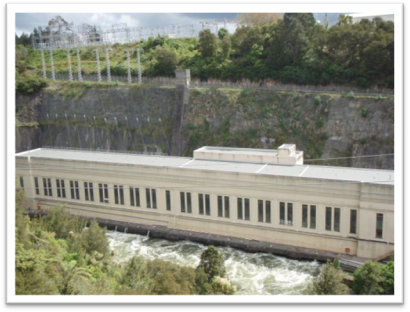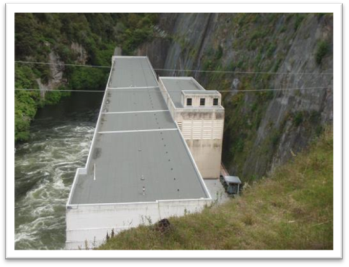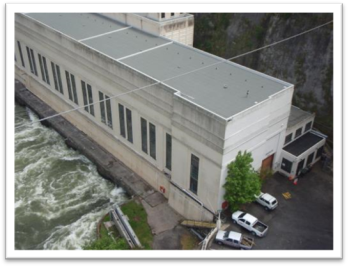HH-02: Arapuni Power House

Date of Photograph: 29 October 2008
Location and Zoning Information | |
Address |
Powerhouse Rd, Arapuni |
Current Owner |
Mercury Energy Ltd |
Legal Description |
|
Zoning |
SPZ-ELG |
Valuation Number |
0541223500 |
Google Maps Link |
|
Architecture | |
Date of Construction |
1924 - Completed 1929 |
Materials |
Steel frame reinforced concrete walls. Galvanised steel frame windows glazed with glass at least 21lbs per sq ft. Roof flat concrete slab to 100lb per sq. ft. Generator floor mass concrete, others reinforced concrete. (HNZPT). |
Architecture/Engineer/Builder |
F.W. Furkett, Engineer-In-Chief. Frederick Templeton Manheim Kissel - Engineer. Builder: Sir William G. Armstrong, Whitworth and Co. Ltd of Newcastle-On-Tyne 1924-Dec 1927. NZ Public Works Department Dec 1927-1929, (HNZPT) |
Condition |
Good condition and high level of integrity. (HNZPT). Extensions (new superintendent's office of reinforced concrete and roof waterproof) commenced Aug 1934, completed 1938. Further units commissioned 1945. (HNZPT). Security fencing limits access to the site. No particular protection other than routine building maintenance. (Mighty River Power, Feb 2001). |
Original Site Recommendation |
HNZPT Ref: 4376. Heritage Advisor, HNZPT. Additional information can be found in "The History of Arapuni" I. J. Southward. |
Current Use |
Hydro-electricity generation |
Statement of Significance | |
(1 Historical) - was associated with events, persons, organisation, institutions or ideas of importance in South Waikato history, Chief Engineer FW Furkett; availability of public power; dairy industry links. Powerhouse associated with first state built hydro dam on the Waikato River, public works. Reflects important or representative aspects of South Waikato and New Zealand history, hydroelectric power scheme in NZ. (6 Educational) - has the potential to educate public about the history of South Waikato, item on a potential heritage trail, school programme potential - study of technology. (9 Technological) - was important in the development of technology, technological innovation or technological processes, constructed in two parts, designed so the generation capacity could be expanded up to eight generators. (11 Context) - forms part of a wider historical and cultural complex, Arapuni Power Station and Township. (13 Integrity) - has a good level of integrity, good condition. No additions or major alterations. District Plan Rules Demolition - NC. Protection focus - 1, 6, 9 and 11. Mitigate the effects of demolition by requiring the applicant to provide Historical Building Documentation (HBD) which should include: the structure history, photographic documentation and measurements of the item prior to removal. Alterations necessary for the primary purpose of improving structural performance, fire safety or physical access – CON -Refer to HH-R2. Other Additions/Alterations - DIS. Protection focus - 6, 9, 11 and 13. Effects can be mitigated/remedied through; a) HBD - See mitigating the effects of demolition. b) Design rules: 1.The overall visual character/shape of the original building should be identifiable. The addition should not dominate the existing building. 2. New work should be restricted to the rear of the building and not be evident from the road frontage. 3. The following special elements that are associated with the rarity or architectural uniqueness or craftsmanship of the structure should be retained: Elements of the structure that should be retained are those elements associated with the structures historic character, use, rarity, landmark values, and craftsmanship etc. i.e. façade, exterior walls, openings, landscape and any other special elements identified in the HBD. c) Building Materials Rule: If repair of the buildings is proposed the materials used for the exterior walls and elements should be similar in type, dimensions and profile as the existing exterior fabric of the building. Repair of the Structure - PER. Refer to HH-R1. Protection focus - 6, 9, 11 and 13. Building Materials Rule: If repair of the buildings is proposed the materials used for the exterior walls should be similar in type, dimensions and profile as the existing exterior fabric of the building. Design Rule: Repair or replication work should match the existing design and profile of element. Re-use/Change of Use - PER. Refer to HH-R1. Protection focus - 1, 6 and 13. Internal Changes - PER. Protection focus - 1 and 9. Relocation - DIS. Protection focus - 1, 11 and 13. Disturbance of the site surface/earthworks - Note: Any place that was associated with human activity prior to 1900 and is able to provide evidence relating to the history of New Zealand is an 'archaeological site' (refer to definition of 'archaeological site' in Section 2 of the Heritage New Zealand Pouhere Taonga Act 2014). All archaeological sites are protected under the Heritage New Zealand Pouhere Taonga Act 2014 and approval from Heritage New Zealand must be obtained prior to destroying, damaging or modifying any site. Accordingly, where this site on which a building is located is an 'archaeological site' and the building is to be repaired, added to, relocated or demolished and this involves disturbance to the surface and/or subsurface of the site, approval from Heritage New Zealand is required.
| |
History | |
First state built hydro dam on Waikato River. For many years New Zealand's largest dam at 157,000KW. Length 136.33m width 22.87m, tailrace water level to roof 21.96m. The Arapuni complex (Dam, Powerhouse & associated works) was of an unprecedented magnitude in New Zealand engineering. Public doubts were raised about the Public Works Department ability to undertake the project. In the end the Department's layout and design were adopted but overseas contractors, Armstrong, Whitford & Co Ltd, carried out construction. Powerhouse was constructed in two parts - the north end of the building between 1924 and 1929, and the south end was added between 1934 and 1946. (Mighty River Power Feb 2001). The first electricity from Arapuni was delivered on 4 June 1929. Power generation was stopped in 1930 when damage to the station was sustained as a result of significant rock movement. Remedial works were carried out by the Public Works Department and the generation of electricity resumed in April 1932.(HNZPT). | |
Additional Photographs

